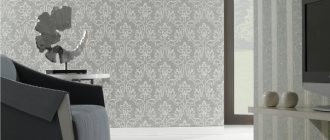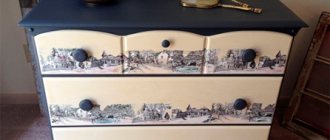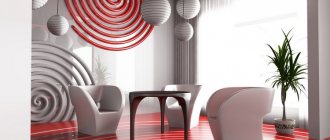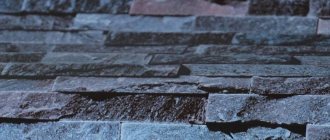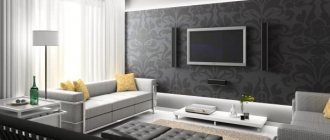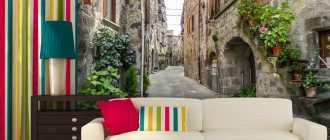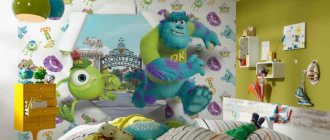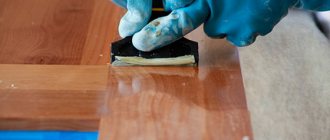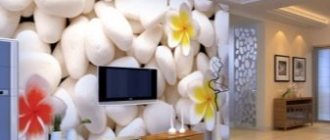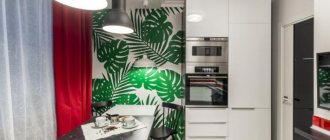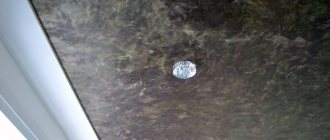One of the common techniques for decorating furniture is decoupage with wallpaper and other paper materials. Most often it is performed to give old furniture an original look. This will also hide damage acquired over the years, renew and extend the life of your favorite item. This decor will allow you to transform the furniture so that it fits perfectly into the interior of your apartment or house.
Decoupage is very diverse. With its help, you can revive individual parts or entire furniture by gluing individual scraps of wallpaper. Using decoupage, you can create an original thing with your own hands that will decorate your home and meet the requirements of modern decor.
Method of execution
If decorating using the decoupage wallpaper technique with your own hands is done for the first time, then you should not immediately start with complex irregularities. It is better to learn decorating on flat areas, such as cabinet doors, refrigerators or countertops. Use partial placement of patterns. For beginners, the patchwork decoupage technique is best suited. Before starting work, you need to carefully think through and complete the sketch, highlighting the main elements on it. This will make the job much easier. You should also prepare all the materials that are needed: specialized glue and colorless acrylic varnish.
When performing decoupage, we follow certain rules:
- we clean the desired area from various contaminants, wipe it and wait until it is completely dry;
- We seal various damage and cracks with vapor filler. If there are major damages, then use putty;
- We begin grinding the surface. To do this, attach fine abrasive sandpaper to a special grater. Bring to a smooth state;
- we align the wallpaper to the intended dimensions or lay out a sketch of a pattern from scraps;
- Apply glue to the wallpaper and leave for five minutes to absorb;
- After the time has passed, we glue the wallpaper sheet gradually, level it with a roller, starting from the center, to the edges. Everything should be done carefully, since paper soaked in glue is very easy to spoil;
- After the glue has completely dried, the edges of the wallpaper are very carefully and thoroughly sanded and coated with acrylic varnish.
Accessories for decoupage
Decoupage has a large field for creative expression. But without special accessories and materials, you cannot expect an attractive, neat product.
What is needed for proper decoupage?
For this type of needlework, the following accessories are required:
- small scissors with sharp tips. You can use nail scissors, medical or special tapestry cutting tools. An important condition is that such tools must have a short, sharp blade. It is best to use scissors coated with Teflon. They do not rust, there are no traces of paint or glue left on them.
- a decoupage knife with a rotating blade or a scalpel. It is used to process high-density materials
- various brushes for shading, applying glue, finishing coat. Brushes should be made of synthetic material, varying in thickness. It is equally convenient to use a soft foam sponge or sponge.
- primer used to prepare the coating. Can be replaced with PVA glue or putty with acrylic.
- special glue intended for decoupage (for applications of higher density) or PVA, wallpaper, paste, acrylic varnish, egg yolk.
- background paints – acrylic, pastels, pigments.
- roller to “drive out” the bubbles and smooth out all the “wrinkles”.
In decoupage, the following materials are used:
Napkins. They are distinguished by their low price and availability. Suitable for beginner handicrafts. Napkins are purchased both in specialized hobby departments and in regular stores.
A pack of napkins is not very expensive, so if you make a mistake you can easily correct it by sticking a new motif.
The disadvantage of napkins is that they are difficult to glue, as they tear and stretch during use. It is better to glue the napkin on a light background; on a dark background the design will not be noticeable.
Decoupage cards. They can only be bought in handicraft stores. These are various kinds of images that are combined into a common picture on a specific topic.
Rice, banana, mulberry paper. All these types of paper are fibrous materials that are used to decorate transparent glass surfaces.
This type of paper should be handled differently from others. The images are torn out by hand, as scissors cannot cut this material. The advantages of the material are that it does not tear and follows the outline of the object.
Printouts. They are suitable for those who are passionate about the idea of making a unique decor using a printed design.
This method requires the use of the most inexpensive paper or tracing paper, because they absorb paint well and do not stand out on the surface of the product. To prevent the image from blurring, it must be sprayed with hairspray.
Features of decorating with wallpaper
If you already have some skills in creating decor with wallpaper, then you can use more sophisticated techniques.
- Special aging, which is manifested by the presence of cracks. To do this, dark paint is applied to the furniture. The color matches the color of the cracks. One option is gold or silver dye. After the base layer has completely dried, it is necessary to cover it with craquelure varnish. When the varnish is partially dry, very quickly apply the paint of the main shade;
- abraded effect. To achieve this, you need to rub certain areas with wax and apply paint on top of it. After it has dried, we treat the waxed areas with sandpaper;
- patination effect. This technique involves darkening certain areas of the furniture. Most often, the patina is black or metallic. Mainly applied to corners;
- toning effect. Achieved by adding shiny additives or a small amount of colored paint to the varnish;
- using the potal technique. Application of metallized paints: gold, silver, bronze, etc. You can also perform the potal technique using crumbs or thin metallized sheets.
Decoupage of kitchen furniture
To understand all the nuances of the process, you need to start with simple decoration. You can decoupage furniture in the Provence style with your own hands using paper napkins with the image of a bouquet of flowers.
To make the master class complete, you should consider all types of surfaces and techniques for working with them.
Surface preparation
High-quality surface preparation is the key to a positive result.
If you are decorating a wooden wall, old chips, knots, and holes cannot be avoided. Therefore, it is necessary to first putty all visible imperfections. Then the surface is carefully sanded with sandpaper. First the coarser spray, then the finest. The preparation of the wooden surface ends with the application of a wood primer.
If the design will be glued to plastic or glass furniture, it is important to degrease it with alcohol or dishwashing detergent and lightly sand it. For primer, it is better to use acrylic art or automotive primer.
Metal furniture must be degreased, sanded and be sure to get rid of old rust. Citric acid and soda, vinegar will help with this, but it is best to purchase a special solvent. Metal is primed using the same means as plastic (glass).
Preparing the drawing and applying glue
For beginning craftswomen, cutting out beautiful patterns with uneven edges and all sorts of elements can be quite difficult. The napkins are thin, so you need to handle them carefully. In our case, a floral motif is used.
To cut out small leaves and branches, use scissors with sharp ends, directing the cut from the edge deep into the design and so on around the entire perimeter.
You need to apply the glue with a soft brush to the back side of the element, after which it is applied to the surface intended for decoration. After gluing with the same brush, the paper is leveled, small folds and air bubbles are removed.
Surface varnishing
After the image has completely dried, you need to coat it with varnish to protect it from the external environment, as well as for decorative purposes. Varnishing is carried out in several layers, with an interval of 1 hour.
Decoration materials
Since furniture decoration with wallpaper has become more popular, manufacturers are keeping up with the times. Therefore, along with paper wallpaper, adhesive wallpaper for furniture has appeared on sale. They differ in that an adhesive layer is applied on the reverse side, protected by a thin film. Typically, adhesive wallpaper is a vinyl sheet with a printed pattern. Advantages of their use:
- quite low cost;
- very easy and simple to fix;
- Damaged wallpaper can be replaced quickly and without complications;
- Wallpaper is unpretentious in care and cleaning;
- a rich variety of colors and textures.
To carry out the procedure for decorating furniture with adhesive wallpaper, you need to prepare the following tools:
- wallpaper knife or scissors;
- dry cloth napkin;
- roller for leveling wallpaper;
- cleaning solvent;
- putty, which is used to level a wooden surface;
- sandpaper with medium abrasive.
Self-adhesive wallpaper
For high-quality furniture decor with self-adhesive wallpaper, we will provide a step-by-step algorithm:
- Preparation. We inspect the furniture and carry out the surface leveling process. We fill cracks and other irregularities. After the putty has dried, sand it using sandpaper. Then we perform degreasing. For this, acetone or solvent is used. Apply acetone to cotton wool or a napkin and wipe thoroughly;
- dry gluing. This process is carried out in several steps. First of all, we take the appropriate measurements and cut the wallpaper sheets and roll them into rolls. Immediately before gluing, remove the edge of the canvas (5–10 cm) from the protective film. We apply the side with glue to the surface and begin to level it with a roller. Next, gradually removing the protective film and, working with a roller, glue the canvas.
If it turns out that after finishing the work, air bubbles have formed, you need to carefully pierce them with a needle and remove the air;
- wet pasting. This is used when it is necessary to cover large areas. In such cases, the protective film is removed completely, after laying the front side of the canvas on the floor. Then we moisten the adhesive layer with a soapy liquid using a spray bottle and apply the canvas to the furniture. Due to moisture, the canvas can move along the surface. You can use such furniture after 10–12 hours.
Decoration examples
Reviving furniture with your own hands and turning it from junk into a modern work of art that will harmoniously fit into the interior is the dream of any housewife. Let's present a master class in furniture decor. It will provide the basics of decoupage with aging elements for beginners.
- Decoupage of an old chest of drawers. This master class presents the technology of reviving a chest of drawers that has been in the house for a long time and is already obsolete. First, apply white paint to the prepared and cleaned surface of the chest of drawers using a roller. While it dries, cut out flower appliqués from the remaining wallpaper. Then we use sandpaper to go over the surface of the chest of drawers. Then we glue the appliqués using PVA glue. After drying, cover the areas with applications with PVA glue. This chest of drawers is suitable for a vintage style interior;
- Master class for beginners - decoupage of a chair in Provence style. Begin work by removing varnish or paint using sandpaper. Then it is treated with coarse sandpaper, gradually reducing the abrasiveness, until a perfectly smooth surface is achieved. Then we cover the chair with white acrylic paint. After complete drying, coat with paint of a darker shade. We select applications for decoupage in Provence style. Those places where they will subsequently be cleaned with sandpaper are treated with wax. We paste the appliqués in pre-designated places. Apply curls with paint of the appropriate color, adhering to the chosen style. We go through the places where the wax was applied with sandpaper, and cover everything with a finishing layer of varnish.
Stylistic directions
There are several main styles of furniture decoupage. To create masterpieces at home, the following directions are most often chosen:
Provence. This theme originates in France. A light background and decorations in pastel colors are chosen as the basis. A varnish composition with a craquelure effect allows you to add refined notes.
High tech. Urban images of large cities are chosen as decor. In addition, details from newspaper clippings with raw edges are used.
Vintage. This direction allows you to make beautiful decoupage of furniture with your own hands using a contrasting combination of colors. The design is done in black and white or blue.
Shabby chic. Decoupage in this theme is widely used for restoring antiques. The design consists of frayed borders and blurred edges.
Victorianism. This type of decor requires a number of skills when working with paints and varnish. During the work, they use drawing lines and additional decor in the form of gold and emerald tones.
Rococo. It bears some resemblance to Victorian decor. A distinctive feature is the use of a light background with a large number of colors and ornaments. You can add accent details by manually redrawing individual areas.
Simple decoupage from wallpaper: decorating old furniture
A master class on decoupage techniques can easily be found on sites with similar topics. The decoration of wooden cabinets, tables, stools, chairs and even the floor is described in detail and filmed.
What you need to turn an old piece of furniture into a work of art:
- Sandpaper with a rough abrasive surface;
- A piece of wallpaper;
- Old furniture;
- PVA glue;
- Alcohol;
- Primer;
- Water;
- Paint for wood.
To get into the decorative scheme using the decoupage technique, below is an algorithm using the example of decorating the top shelf of an old chest of drawers.
The decoupage process is as follows:
- First you need to sand the surface that you intend to decorate with sandpaper, removing the entire top layer. Particular attention should be paid to furniture with a varnished surface. The varnish must be removed completely without leaving any gloss. Otherwise, the wallpaper may not stick to the surface.
- Then, using alcohol and a napkin, degrease the entire working surface of the shelf;
- The next step is to apply a coat of primer and paint;
- Next, you need to prepare a piece of wallpaper: place the wallpaper in water for better attachment to the work surface. Place the soaked wallpaper on a paper napkin.
- Apply glue to the surface of the chest of drawers and to a piece of wallpaper without removing it from the napkin.
- Next, carefully place the wallpaper with glue on the surface of the shelf and only after that, remove the napkin, being careful not to tear the piece of wallpaper;
- Remove excess glue with the same napkin or dry cloth;
- The final stage is the application of paint or furniture varnish, which is not necessary, but furniture varnish will give the chest of drawers and the picture on it a finished look.
What should be the decoupage of chipboard furniture?
If pieces of furniture are made of chipboard, then the decor can be anything. The main thing is not to forget to degrease the surface. To carry out this procedure, the detergent you usually use to wash dishes is suitable.
DIY decoupage: vinyl wallpaper as a three-dimensional pattern
Vinyl wallpaper with three-dimensional ornaments and patterns will help to add an unusual decor to furniture. The remaining piece of wallpaper should not be thrown away, because it will help when decorating old furniture and interior items. The result will help turn ordinary cabinet doors into an element of style.
In addition to the basic items for decoupage, you will need spray paint with a metallic effect, such as gold, copper or silver.
Having prepared the cabinet doors, you need to place a piece of wallpaper on them, pre-coated with glue. At the same time, there is no need to soak it in water, as is the case with a chest of drawers and paper wallpaper. It is enough to thoroughly coat the desired side with glue, as with normal gluing during repairs, and leave a piece of wallpaper with the glue for 15-20 minutes so that the wallpaper absorbs more glue. To prevent the glue from drying out during this time, simply fold the wallpaper in half.
The next step is applying wallpaper to the cabinet doors. The technique is the same as when gluing wallpaper on a wall. Carefully remove all bubbles without damaging the pattern and straighten the wallpaper on the surface. Before spraying paint, it is better to wait some time for the glue to dry to prevent the material from getting too wet. After applying the paint, it will be enough to wait until the paint dries. There is no need to apply furniture varnish. After all, metallic paint will give the desired gloss and shine to the updated doors.
Photo of do-it-yourself furniture decoupage
Read here: How to make a bench - beautiful and unusual options for making garden benches (135 photos)
Decorative decoupage with wallpaper: master class
A decorative and beautiful look can be given not only to the closet. By choosing several patterns from one piece of wallpaper, you can decorate kitchen wooden stools. The technique is the same for all furniture.
You will need:
- Several cut-out wallpaper fragments;
- 4 wooden kitchen stools;
- PVA glue;
- Sandpaper;
- Water;
- Furniture glue;
- Alcohol;
- Paper towels;
- Textile;
- Primer and paint;
Sand the stools, removing excess paint and surface unevenness. Apply a coat of primer and paint. Soak the cut out wallpaper fragments in water. Apply glue to stools and wallpaper. Place the wallpaper fragments in the desired place on the stool, remove excess glue and reapply the glue in a thin layer for stronger adhesion. After the glue has dried, you can apply varnish or use a large-pore sponge to spread a little paint around the design.
You can complete the kitchen ensemble by decorating the doors of kitchen cabinets, window sills or countertops using the same technique and style.
Tools and materials
For work you will need the following list:
- scissors or paper knife;
- paper or special decoupage napkins;
- wood putty or other means for filling pores and eliminating defects;
- sandpaper;
- PVA or decoupage glue;
- acrylic lacquer;
- directly the cut out images themselves.
- brushes for glue and varnish.
Children's wallpaper: decor in decoupage of a toy box
When a baby arrives in the house, the apartment gradually becomes overgrown with many toys. And these are not only cute soft bear cubs and bunnies. These are construction kits, small parts, cars and a lot of little things that often fall under your feet, causing a lot of trouble. Nowadays there are many different plastic containers for storing small toys.
But making such a container with your own hands, and even together with your baby, is a useful and educational activity. Having a wooden box, adapting it as a place to store toys is not a difficult task. And decorating it, attracting a child, is a fascinating procedure.
What you will need:
- Wooden box with removable lid;
- PVA glue;
- Children's wallpaper;
- Water;
- Furniture glue;
- Sandpaper;
The process is similar to any decoration using decoupage technique. Prepare the box for gluing pictures: sand 4 sides of the box and the lid. Cut out pictures from the wallpaper - these can be heroes of fairy tales or cartoons that the baby likes. Or just bright flowers. Wet the cut out fragments with water and place them on a paper napkin to absorb the moisture. Apply PVA glue to the box, lid and wallpaper. Place the pictures in the right places, remove excess glue with a napkin or cloth. Then apply a thin layer of glue again. The box is ready. For gloss, you can varnish the box, although this procedure is not at all necessary.
Necessary tool
Before you begin the process of updating or decorating, you need to stock up on materials for decoupaging furniture: napkins with all kinds of motifs, pieces of wallpaper or fabric.
The following tools will be required:
- Special scissors for decoupage or manicure with sharp tips, a stationery knife.
- Brushes of different widths: small for fine work and wider for treating large areas.
- Sandpaper for leveling surfaces, removing roughness and pre-sanding the varnish layer.
You will need PVA glue for napkins or fabric; if the decoupage technique is performed with wallpaper, then wallpaper glue. The varnish is chosen according to the desired result: matte or glossy, acrylic or water-based.
If you plan to create a three-dimensional drawing or tint, you will need modeling paste or putty and paints. In addition, in the process of preparing surfaces, a primer is used, and if painting is necessary, aerosol paint is used.
Beautiful decoupage of furniture with wallpaper (video)
The decoupage technique is a simple task at first glance. Give the interior an updated look and turn the room or kitchen into a room in the same style, perhaps with the help of simple tools and a few pieces of wallpaper. The creative process will give you many pleasantly spent hours without extra costs. There are no restrictions in the decoupage technique. You can decorate using old newspapers, paper napkins or any paper material suitable for working using the decoupage technique. It is enough to spend a little time and the result will exceed all expectations.
Decoupage furniture with wallpaper
If there is wallpaper left after the renovation, you can use it to decorate furniture with your own hands. The decoupage technique involves gluing paper or other fragments with a pattern onto furniture and then covering it with varnish.
How to cover a closet with wallpaper and photo wallpaper: do-it-yourself decorating instructions, video and photo
To transform the decor in your home, you don’t have to buy new furniture.
Instead, you can update old items by changing their appearance, for example, you can refinish an old cabinet. Moreover, this does not require any special knowledge or skills. You can give your furniture a new look with wallpaper. The only thing is that you should familiarize yourself with some of the nuances of the work in order to complete it with the highest quality. Therefore, next we will look at how to decorate a closet with wallpaper.
Wardrobe before and after wallpapering
Types of decoupage
Decoupage can be done in different ways. Depending on this, different effects and different styles are obtained.
- Classic - the surface of the furniture (entire or individual areas) is covered with paper, fabric, napkins, wallpaper. The top of the composition is varnished.
- Reverse - used on transparent glass. In this case, the fragment with the pattern is smeared with glue on the front side and glued to the glass.
- Artistic - decoupage acts as part of the composition; the design is glued to a surface that has already been painted or otherwise decorated.
- Decopatch - completely covering furniture with various trimmings and scraps of colored paper.
- Volumetric - in this case, a relief decor is created. Particularly suitable for the Baroque style; volumetric repetition of the wallpaper pattern on furniture is also interesting.
Exquisite decor in Provence style
Provence is one of the most popular techniques because it is associated not just with the village, but also with the sea, the sun, the smell of flowering plants, that is, with a wonderful holiday in the lap of nature. All this affected the aesthetics of Provence: sun-bleached colors, like in a photograph, many living and dried plants, naturalness, simplicity, uncomplicated lines. Decoupage of furniture elements in the Provence style must include one or more mandatory colors: white, cream, beige, pale lemon, terracotta, burnt orange, sunflower petal color, blue, pale green, sea wave and lavender.
Technique
The technique of gluing fragments of wallpaper onto furniture is practically no different from decoupage with other materials. One of the few differences is that you need to use special glue. Regular PVA is not suitable for wallpaper, as it is made of thick paper.
For beginners, it will be easy to decorate, for example, a table or a cabinet door, if you completely cover it with wallpaper. Watch the video master class, which shows how you can update your closet with your own hands.
Surface preparation
In order for the surface to be smooth and the design and varnish to adhere well, you need to prepare it. For this you will need
- filler
- putty,
- sandpaper: medium and fine,
- primer.
Surface preparation procedure.
- Before decoupaging wallpaper, you need to clean and wipe the surface.
- Next, fill the cracks. For small ones, filler is used, for large ones, putty is used.
- After drying, level the surface of the furniture with medium-grain sandpaper, and then bring it smooth with fine sandpaper.
- Remove dust and cover the surface with primer or paint if you need to change its color. Acrylic paint will do.
If the surface is varnished, then it is better to remove the varnish, otherwise the acrylic paint may not adhere well, pay attention to how this is done in the master class in the video above. You can remove the varnish with sandpaper. If you do not want to remove the varnish, thoroughly degrease the surface and use special glue and paint. Glass surfaces are also degreased by wiping with alcohol.
Wallpapering
The simplest option is to paste wallpaper onto the entire surface, for example, a table. To do this, first try on the wallpaper, then cut off the required part, leaving 5-7 cm in reserve on all sides. Then glue is applied to the paper and the piece of furniture itself and left to soak for 5 minutes. Then the wallpaper is applied to the work surface with one side and smoothed with a roller from the middle to the edges. After drying, remove excess and sand the edges with sandpaper. Finally, the product is coated with acrylic varnish.
If cut out fragments are used, they are glued in exactly the same way, and then brushed with glue along the edge.
Varnish coating
After the glue has completely dried, the product is coated with varnish, usually in two layers. The second layer is applied when the first one is completely dry. This can be either regular acrylic varnish or wood varnish. For items that will be exposed to moisture, it is advisable to use yacht varnish.
Decoupage techniques
If you are just starting to get acquainted with the technique of decorating furniture with your own hands, do not tackle complex relief objects. Start with simple, flat surfaces such as a countertop, chair seat, or refrigerator. The patchwork technique, which uses several different patterns cut out of wallpaper, is perfect for beginners in this type of needlework. Also, for starters, you can try to decorate the furniture partially, placing just a couple of patterns in certain places, for example in the corners.
There are several types of decoupage techniques for furniture and decorative items, for each of which there is a master class:
- Classic - standard pasting with fabric, napkins, newspaper clippings, wallpaper and other paper and textile materials, followed by varnishing to obtain a smooth surface.
- Reverse - applying a design to the reverse side of a transparent surface, for example, to the inside of the glass in a cabinet door. This method simplifies cleaning the front side of the glass insert and extends the life of the decorative element.
- Artistic - the ornament is pasted onto a background painted with drawings, thereby creating a single artistic canvas.
- Volumetric – involves creating a three-dimensional image using various methods.
- Decopatch is a complete covering of the working surface with scraps of decorative paper of various colors and textures, which are torn by hand or cut with curly scissors and fit tightly to each other.
The varied effects of furniture decor require careful consideration of the details of the finished picture. For better orientation while working, make a sketch, indicating on it all the elements used. This will allow you to perform decoupage at its best without fuss and mistakes.
Self-adhesive wallpaper for furniture
Adhesive, or self-adhesive, wallpaper for furniture allows you to quickly update your interior with your own hands. They are produced in the form of a film that is easy to glue and have two layers: a top, decorative one made of PVC, polyester or polypropylene, and a bottom, paper coated with glue.
Adhesive wallpaper is used for decoration in the same way as regular wallpaper, only without the use of glue. But there are several nuances:
- they are suitable only for smooth surfaces - any unevenness and flaws will only be emphasized,
- The film on furniture doors may peel off.
There are adhesive wallpapers in a variety of colors, imitation wood and metal. There is calendered film - low plasticity, and cast film - soft and flexible. For decorating actively used surfaces, it is better to choose special wear-resistant options.
How to stick self-adhesive film? The surface is prepared in the same way as for decoupage with ordinary wallpaper. Measure and cut out the required sheets of wallpaper with allowances of 2-3 cm on all sides, remove the protective film. Apply the film to the surface, pulling slightly. To cover sharp corners, the film is heated with a hairdryer - this makes it more flexible.
There is also a wet gluing method. Remove the protective layer from the film, place it face down and moisten it with soapy water. It will allow you to easily move the decorative material along the surface. Then the wallpaper is glued into place, pressed, and smoothed. The glue dries in 10-20 hours.
Successful examples
Decoupage furniture is a great solution for a home or apartment.
With this technique you can realize a variety of creative ideas. This design will be appropriate in any room - in the nursery, bedroom, kitchen, living room. A vintage chest of drawers painted in pale gray paint and complemented with bird sticker designs on the doors will look tender. Of the bright details, there can only be dark fittings.
An old, simple cabinet can be treated with white paint and give it a craquelure effect. The unusual furniture should be completed with images of large roses made from napkins. The latter should be glued in the upper and lower parts of the structure.
You can decorate furniture using the decoupage technique using stencils. So, a high cabinet with several drawers and a cabinet can be painted matte or glossy white, leaving areas in the shape of large flowers untouched.
To learn how to decoupage furniture, see the following video.
Add-ons
To get interesting effects, for example, to artificially age furniture, after decoupage you can use one of the following techniques:
- Craquelure is the effect of cracked paint. It uses a special varnish, which is applied alternately with layers of acrylic paint. Due to different drying times, the coating cracks, which creates an antique effect.
- Patina also helps to “age” furniture. This is the darkening of certain areas, usually edges or metal parts.
- Scuffs - artificial abrasions can be created by applying wax to part of the surface, paint on top, and then sanding.
- Potal - decoration with gold, silver or other metallic paint. Use it carefully - too much gilding will look tacky.
- Tinting is adding a tint by adding a small amount of paint or glitter to the varnish.
Original decoupage of doll furniture
Furniture for dolls is often only one color without additional decorations, so it does not always look beautiful. To decoupage doll furniture, you need to prepare certain materials.
Doll furniture decorated using the decoupage technique will fit well into a children's room.
It is also best if the furniture is made from:
- Trees;
- Plywood;
- Cardboard.
On a doll's bed, table, chest of drawers and other objects there can be beautiful patterns cut out of paper napkins. In addition, you can decorate furniture for dolls and other items in the dollhouse with a beautiful photograph of picturesque landscapes, cartoon characters or animals.
When decorating doll furniture, special care must be taken, since all surfaces are small, and the design must be applied more carefully. In addition, to make doll furniture look more interesting, you can use various items to decorate it.
Interior design, repair and decoration with your own hands.
Decoupage furniture with wallpaper
The art of decoupage was known back in the Middle Ages. Thus, back in the early 15th century, pieces of furniture and various household items were decorated with cut-out pictures.
The art of decoupage reached a particular flowering in Venice, where many furniture manufacturers actively used this technique to decorate furniture sets.
Today, decoupage has become an extremely popular type of needlework, because many craftsmen have paid attention to the simple technique of gluing pictures, which helps to give a completely different look and often gives new life to outdated pieces of furniture.
Old furniture can be given a second life by covering it with leftover wallpaper.
This way you can tidy up old or worn-out furniture. Therefore, each of us is able to decoupage furniture with our own hands - fortunately, the technique is not particularly difficult.
The art of decoupage can give furniture a completely new look
So, you can glue wallpaper from leftovers to various furniture surfaces. The main thing is to be guided by your own taste preferences in choosing materials, and also to do the work carefully and accurately.
The headboard of the bed is decorated with wallpaper
Materials for decoupage
Many types of materials are suitable for decorating furniture using the decoupage technique, including the following:
- Wallpaper
- Textile
- Napkins
- Lucky
- Paints
- Chipboard
For beginning craftsmen, it would be best to try their hand at the technique of decoupaging furniture with wallpaper. This is quite easy to do, and is also affordable, because pieces of old wallpaper left over from renovations can be found in almost every home.
Decoupage furniture with small pieces of wallpaper
Preparing for work
Before gluing pieces of wallpaper onto furniture, it is recommended to thoroughly clean the selected surface from dirt, stains, as well as scratches and cracks.
It is best to pre-treat the wood with sandpaper to achieve maximum adhesion of the wallpaper to the surface.
Stains that are difficult to remove can be painted over with acrylic paint of the desired tone, and deep scratches can be carefully repaired using wood putty.
Before starting work, the surface of the furniture needs to be prepared
Types of decoupage wallpaper
There are several types of decoupage with which you can successfully decorate pieces of furniture:
- The patchwork decoupage technique involves gluing separate pieces of several types of wallpaper with different patterns. In many ways, this type of decoupage is similar to the patchwork technique.
Patchwork furniture decoupage technique
- Solid decoupage involves applying large pieces of wallpaper to pieces of furniture. This will allow you to decorate cabinet doors or other surfaces in a single color scheme and style.
Finishing furniture with large pieces of wallpaper
It will be great if the wallpaper for decoupage is chosen to match the tone of the wall decoration. This will help create a touch of harmony in the interior design. A tastefully decorated wardrobe or bedside table using decoupage technique will add an elegant twist to the design of the room.
Wallpaper for finishing the cabinet is matched to the tone of the wall decoration
- Interior decoupage involves wallpapering the inside surfaces of cabinets, cupboards, bedside tables, racks and shelves. This decoupage method helps transform the appearance of open furniture beyond recognition, making it more original and bringing an atmosphere of comfort.
Decoupage wallpaper on the inner surface
The only drawback of this type of decoupage is that the work must be done extremely carefully and accurately, but the result will definitely please you.
The inner surface of the cabinet is covered with wallpaper
- Decoupage of large surfaces is also one type of furniture decor. You can decorate the doors of an old cabinet with solid wallpaper, giving it a completely new look. In addition, this type of decor will help add a characteristic touch to a stylish interior.
Decoupage of a wardrobe - compartment with wide sheets of wallpaper
Decoupage ideas in the kitchen
We often inherit pieces of furniture that have retained their quality and functional properties, but have lost their attractive appearance. In this case, the question is raised about restoring the facades with your own hands and at the same time creating original interior items.
Decoupage of a cabinet or kitchen chest of drawers can be done using any method, taking into account the style of the room:
- Country or Provence will be emphasized by images of butterflies, wildflowers, landscapes or still lifes.
- Eco-style accepts everything related to nature: flower bouquets, vines, waterfall patterns, zebra or leopard colors.
- Black and white newspaper clippings, silhouettes of human figures or faces, and theater posters will fit well into the retro style.
- Any interior will be successfully emphasized by various geometric shapes and covers of popular glossy magazines.
Tables, chairs, dishes, porcelain containers and flower vases are decorated. They create panels and paintings based on kitchen motifs.
